Having served as a producer on films like They Live, In the Mouth of Madness, and Village of the Damned, along with her work running Storm King Comics, Sandy King knows a thing or two about how to tell a frightening story in the genre space. For the upcoming Peacock series John Carpenter’s Suburban Screams, King ventured into new territory, as the series explores real-life tales of terror, featuring not only dramatizations of those events, but also interviews with the people who experienced the unsettling encounters firsthand. John Carpenter’s Suburban Screams premieres on Peacock on October 13th.
Videos by ComicBook.com
The new series is described, “John Carpenter’s Suburban Screams is a genre-busting unscripted horror anthology series from the mind of legendary director, writer, and producer, John Carpenter. The series explores the dark secrets and unspeakable evil that sometimes lurks beneath the surface of the sun-drenched streets, manicured lawns, and friendly neighbors of suburbia. Each episode focuses on one true tale of terror, told by the real people who lived through it. Their firsthand accounts are brought to life through premium cinematic scene-work, news clips, home photos, and archival footage, combining the visual language of horror films with the tools and techniques of documentaries, creating a uniquely frightening experience for viewers.”
ComicBook.com caught up with the producer to talk developing the new series, the challenges of bringing it to life, and more.

ComicBook.com: As someone who follows along with basically everything that you and John get up to, when he casually mentioned he directed a TV show a month or two ago, I was like, “What the hell is he talking about?” So how did Suburban Screams come together? Was it something you two had been working on for a long time, just under wraps, or did it come to you?
Sandy King: Well, it was all under wraps, but it came to us from the production company, DIGA. They had a great idea, and we’re always up for new challenges. We don’t like doing the same thing all the time. The idea of this hybrid show that was scripted and unscripted combined seemed really interesting, just because we hadn’t done it before.
Also, the notion of what the stories represented was pretty interesting. Suburbia is a fun place to examine horror. For all the reasons that it seems safe and very obviously isn’t. It’s the monster under your bed. And then the fact that what we did was focus it on the survivors, the people left behind, the people who’ve been either the victims or those next to them or what was happening. In the case of a community held hostage, a person stalked, any one of those things, they’re never not affected. We tend to think of crimes that are solved as having closure, but do those people ever really walk away unscathed? They don’t. You can’t help but be affected.
In the case of the one John directed, you have a woman who, six years later is still being stalked. You don’t come away unscarred.
That one was particularly horrifying to watch, because so many people are used to, “…and then the cops caught him and that was it, and then they moved on.” Just knowing that that is still going on definitely takes things to another level, in my opinion. From the time that you and John got involved, how much, if at all, did it change, did it evolve? Did you shine different perspectives on it? Did you alter the stories? Did you alter the tone, or is it pretty similar to what that core concept was?
We changed it to being survivor-based, victim-based, because the idea was, why do what’s already being done where everybody focuses on the crime, focuses on the murder or that kind of thing, and that if it’s already being done, why do it? We chose the stories we thought were the strongest because there was a slate of them.
The other thing we really pushed for was how to have an hour of what we do best — entertaining — in the realm of reality, where your interviews and your real pieces are the touchstones that remind the audience in the middle of the scripted portions. Yes, this really happened, and we also really kept a leash on it to not make the scripted portions untrue. Everything in these stories happened, we just heighten it. We want to make it a more immersive experience, where you’re not just sitting back as a voyeur, we immerse you more in it.
What we brought to the reworking of the scripts and the template for how they’re shot, those things, was to say, “Okay, what do we know from horror movies?” You have to come full circle. So we brought those elements into it when we were dealing with the writers and directors. How do you make this work so that our fans still get their thrills, but we’re still being true to our subject matter.? There’s only bits of, say, 10 seconds here or there that are more hallucinatory or more emphasizing the interior aspect of our characters.
That’s another thing that I was very curious about is your background, your and John’s backgrounds coming from the genre space, the horror film, the sci-fi space. How did you find that balance, whether it was in the script, in the direction, in the edit, how do you find that balance of being true to the real-life stories while also telling a good story? Because I’m sure that there’s some contradictions in people recalling what happened to them, or some minor discrepancies, so how do you find that balance while also not exploiting or making light of these true life terrors that these people really went through?
I think the key there is to not make light of what their truth is, and their truth is their fact. It’s what they live, and so what you have to do is respect what it is they now live with forever. If you look at what recently happened in Pennsylvania where the serial killer escaped and for two weeks essentially held that area captive and terrorized them, those people are going to live with those fears forever in some regard. Everybody else wants to think, “Oh, it’s all okay. They caught the killer, the town is saved, no big deal.” But those people are always going to be a little hesitant. They’re always going to be a little fearful of what was so familiar and safe to them before. The same thing applies to all the people whose stories we tell. They’re always going to live with that kernel of truth in them, their truth, that is going to make them afraid or changed in some way.
That’s a truth that we can’t betray if we’re telling their stories, and remember that we met these people and interviewed these people, so there’s a trust in their relationship with us, and you can’t be jerks and then just suddenly put swamp monsters in their story or do something that makes it so that we think it was more terrifying. What terrified them should terrify our audience. We bring our skills into saying, “Okay, let’s go through this. Let’s find the parts of their stories that is what really drove them.”
I feel like maybe it’s a weird way to phrase this, as saying what your “favorite” episode is, because to say your “favorite real-life terrifying tale” isn’t the way to phrase it, but is there an episode that you’re particularly proud of, either because of the story that you got to tell or because of the way that the more cinematic elements of them came together?
Well, I’m really proud of the one John did, because I think we managed to get across the slow disintegration of this woman. I think that Julie [Stevens], the lead actress, really caught the paranoia as it grew and grew. I felt like we managed to make a suspense story really grow until her final falling apart and where she is now and the fact that it’s still going on. So that’s a big challenge when you have something that isn’t an ax murderer, when you have something that isn’t hanging bodies in a shed.
I think, also, that Bunny Man is really successful, because basically that’s a hundred-year-old legend and that had a couple of foundations in fact that grew because of parents throughout the years trying to scare their kids into coming home at night. There were two modern occurrences that were in newspapers and things that didn’t involve any deaths and all of that, but it grew largely because it was the age of when John Walsh’s kid was kidnapped and that heightened everything, so various real-life occurrences played into the myth of the Bunny Man. I’d say probably the most artistic license was taken in reenactments in Bunny Man, but they were examining the legends that grew up around it, but I thought that was a very successful one that John directed.
Did you envision this series as a limited event or could this be coming back for future seasons further down the line? I know it depends on how audiences react to it, but would you like to continue this or was this a one-off limited series experiment?
It’d be fun to do more. We’d both love to have another season of it if the fans like it. That all depends on the numbers that come in. So far, the network seems happy, but the proof is going to be in how many people watch it, and they like it.
When this TV show, when the murmurs of it first started to come out, you and John had previously been working on Tales for a Halloween Night show and some people thought maybe there was an evolution from that into this. Is there any status update on that project, which seems to be its own very specific, unique thing that I know you’ve both been working on for years?
Well, that all fell apart when Discovery bought TNT, and they stopped unscripted and all that. I believe it’s moving on for a second life at another network. We’ll see what happens with that because it’s a very different project. We’ve got, oh God, about four different projects at different places right now. And now that the writers’ strike is settled, we’ll see whether they all rise from the dead. Some of them … Who has a stake through its heart and who walks like a zombie, I have no idea.
I’m a big They Live fan. It feels like, every year, it gets more and more prescient and more like reality and people are like, “There should be a new update of ‘Eight O’Clock in the Morning’ because it’s so relevant,” and all that stuff. Whether you were involved in it or not, do you think that’s a story that could be told today, or would it feel almost like just too on the nose, too obvious of a thing to tell, given the current technology culture and political climate?
That’s a little like watching CNN now, isn’t it? I think that if you stay tuned, you might actually see something before too long.
I don’t know if I should go grab a pair of sunglasses about what I’m about to see in the real world, or if that is a tease that maybe there is a new piece of entertainment on the way to keep my eyes out for.
There might be.
John Carpenter’s Suburban Screams premieres on Peacock on October 13th.
This interview has been edited for length and clarity. You can contact Patrick Cavanaugh directly on Twitter.








